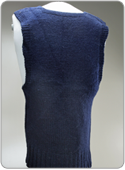An army of knitters in support of the war effort
March 10, 2014
Knitting garments for soldiers, sailors and airmen was one important way for women to contribute to the Second World War. Knitting helped women at home stay connected to those who had gone off to fight — it was a tangible means of being involved.
Moreover, knitting was something that anyone could do, regardless of skill level. Beginners could start with scarves or bandages. More experienced knitters could make gloves and socks.
With the Canadian Red Cross Society in charge of quality control, some knitters took on the task of correcting mistakes made by others, such as knots in the heels of home-knitted socks. “I hate to think of the poor boy’s feet after wearing a pair of those,” said one Red Cross volunteer in a 1944 story in the Globe and Mail. “I rip them back and knit it up again.”
To list what was needed, and the patterns, wool types and colours to be used, the Red Cross published the first of a series of pamphlets in February 1940. It was titled Knitting Instructions for War Work.
It gave instructions for various garments required by the different armed forces. The army’s requirements included army socks, bedsocks and coverings for knees and wrists. Mitt types included rifle mitts with trigger fingers, and patterns were available for headgear to be worn under metal helmets. Instructions for the other services included seaman’s stockings, long stockings and aero caps.
In May 1941, the Red Cross published the fourth in its series of knitting instructions. It focused on garments for civil defence workers. This pamphlet, as well as other documents related to the home front, is part of the War Museum collection that belonged to Margaret McGuire of Elmvale, Ontario.
The Red Cross patterns were widely reproduced by the makers of LUX soap, Monarch wool and other businesses. In 1941, a Monarch publication described the extent of the contribution being made as: “[an] industrial effort reaching into practically every home — representing virtually the complete mobilization of women — to the end that peace may come more quickly.”
This was no exaggeration. After the war, the Red Cross estimated that some 750,000 women produced more than 50 million garments. There was indeed a veritable army at the home front, doing its part to win the war.